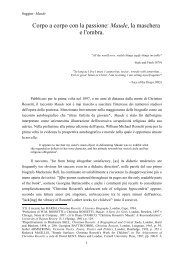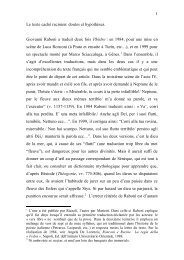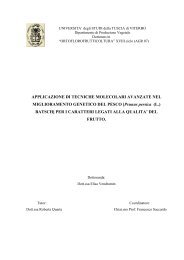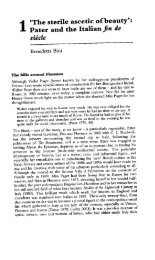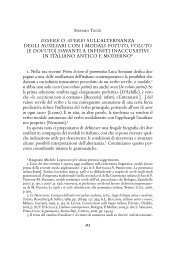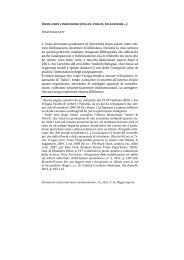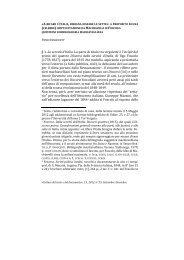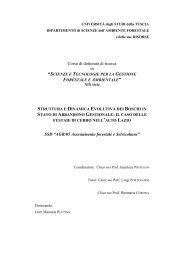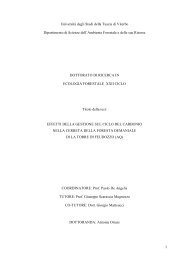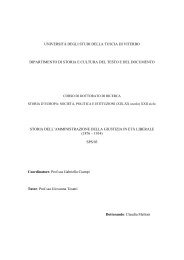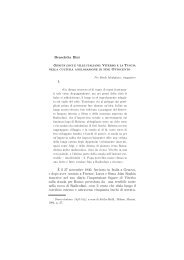drivers of soil respiration of root and microbial ... - Unitus DSpace
drivers of soil respiration of root and microbial ... - Unitus DSpace
drivers of soil respiration of root and microbial ... - Unitus DSpace
Create successful ePaper yourself
Turn your PDF publications into a flip-book with our unique Google optimized e-Paper software.
change <strong>and</strong> <strong>soil</strong> processes <strong>and</strong> to predict ecosystem responses to climate change (Melillo et al.,<br />
2002; Ryan <strong>and</strong> Law, 2005).<br />
Fig. 4 Five main sources <strong>of</strong> <strong>soil</strong> CO2 efflux from <strong>soil</strong>, ordered according the turnover rates <strong>and</strong> residence time in<br />
<strong>soil</strong>. Modified after Kuzyakov (2006).<br />
18<br />
In regard to the CO2-driven green house effect, the last three sources <strong>of</strong> CO2, because <strong>of</strong><br />
their fast turn over rates, do not have a significant effect on the C sequestration in the long <strong>and</strong> short<br />
term. The long MRT <strong>of</strong> SOM <strong>and</strong> low turn over rates means that it is the only C pool that can be a<br />
real long term sink for C in <strong>soil</strong>. Being a very large reservoir <strong>of</strong> C, it makes it also a huge potential<br />
source <strong>of</strong> CO2 if decomposition exceeds humification. Plant-derived <strong>respiration</strong> in this context<br />
masks the contribution <strong>of</strong> <strong>microbial</strong>-derived <strong>respiration</strong> to the total CO2 efflux, making the total<br />
CO2 efflux unsuitable for direct estimation <strong>of</strong> the contribution <strong>of</strong> the <strong>soil</strong> the changes in atmospheric<br />
CO2.<br />
Root-derived <strong>respiration</strong><br />
Root <strong>respiration</strong><br />
Turnover rate<br />
Plant-derived <strong>respiration</strong> Microbial-derived <strong>respiration</strong><br />
Rhizo-<strong>microbial</strong><br />
<strong>respiration</strong><br />
Total CO 2 efflux from <strong>soil</strong> (Rs)<br />
Microbial<br />
<strong>respiration</strong> <strong>of</strong><br />
plant residues<br />
Priming effect<br />
<strong>respiration</strong><br />
Basal<br />
<strong>respiration</strong><br />
Residence time in <strong>soil</strong><br />
The fact that total <strong>soil</strong> <strong>respiration</strong> is not all SOM-derived <strong>and</strong> do not provide a sufficient<br />
information on whether the <strong>soil</strong> is a net source or sink <strong>of</strong> CO2 have led to an augment <strong>of</strong> the number<br />
<strong>of</strong> both laboratory <strong>and</strong> field studies <strong>and</strong> methods which allow to separate different sources <strong>of</strong> <strong>soil</strong><br />
CO2 <strong>and</strong> to calculate their contribution to total <strong>soil</strong> <strong>respiration</strong>. Partitioning <strong>of</strong> <strong>soil</strong> <strong>respiration</strong> allows<br />
researchers to measure the contribution <strong>of</strong> each <strong>respiration</strong> source to total fluxes <strong>and</strong> to account for the<br />
individual response <strong>of</strong> each source to environmental factors. However, the basis assumptions <strong>and</strong> results<br />
obtained by these methods vary significantly among the studies. It remains unclear if the observed<br />
variation in results is method-dependant due to the fact that each partitioning approach integrates the<br />
biases associated with the proper limitations <strong>and</strong> shortcomings, or reflects varying experimental




